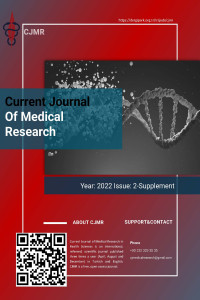Abstract
Amaç: Bu çalışmada İzmir Kâtip Çelebi Üniversitesindeki Tıp Fakültesi öğrencilerinin COVID-19 algısı nedenleri hakkındaki düşünceleri değerlendirilmiştir.
Gereç ve Yöntemler: 2021-2022 yılının Ekim ve Mart ayları arasında 320 kişinin katıldığı ankette 10 adet sosyo-ekonomik ve 14 adet COVID-19 nedenleri algısını belirleyici soru içeren iki bölüm bulunmaktadır. Öğrenciler 9 tanımlayıcı özelliğe göre gruplara ayrılarak tanımlayıcı özellikleri ile komplo alt ölçek puanlarının karşılaştırılmaları yapılmıştır.
Bulgular: Çalışmaya %57,1 (n:178) kadın, %42,9 (n:134) erkek olmak üzere toplamda 312 kişi katılmıştır. Öğrencilerin yaşları 20,87±2,24 yıl, COVID-19 hastalığını geçiren kişi sayısı 60 (%19,2) iken, geçirmeyen sayısı 217 (%69,6) olarak tespit edilmiştir. Komplo alt ölçeğinde yaşanılan yer bakımından apartman dairesi ile yurt arasında istatistiksel olarak bakıldığında anlamlı bir fark vardır (p=0,045). Alkol kullanma durumu bakımından nadiren kullanma ile kullanmama ve günde bir kadeh kullanma durumları arasında istatistiksel olarak anlamlı bir fark vardır (p=0,007). İnanç alt ölçeği ile alkol kullanmada, kullanmama ile nadiren kullanma durumları arasında ve kullanmama ile haftada bir kadeh kullanma durumları arasında istatistiksel olarak anlamlı bir fark bulunmaktadır (p=0,001). İnanç alt ölçeği ile sigara kullanmada, kullanmama ile günde bir paket kullanma durumları arasında ve kullanmama ile nadiren kullanma arasında istatistiksel olarak anlamlı bir fark bulunmaktadır (p=0,02). Total neden algısı puanı ile yaşanılan yer (apartman dairesi ile müstakil ev) değişkenleri arasında istatistiksel olarak bakıldığında anlamlı bir fark vardır (p=0,034). Total neden algısı ile alkol kullanmada, nadiren kullanma ve hiç kullanmama durumları arasında istatistiksel olarak anlamlı bir fark vardır (p=0,025). İnanç alt ölçeği ile komplo alt ölçeği arasında biri artarken diğeri de artan %29’ luk istatistiksel olarak anlamlı bir fark vardır.
Sonuç: COVID-19 hastalığına dair nedenleri algısının incelendiği bu araştırmaya katılan kişilerin çevre, inanç ve yaşadıkları yerlerin farklılıklarına göre neden algılarında farklılıklar gözlenmiştir.
Anahtar kelimeler:
Abstract
Objective: This study evaluated the thoughts of the students of the Faculty of Medicine at Izmir Katip Celebi University about the reasons for the perception of COVID-19.
Materials and Methods: In the survey, in which 320 people participated between October and March of 2021-2022, there are two sections containing 10 socio-economic questions and 14 questions determining the perception of the causes of COVID-19. The students were divided into groups according to 9 descriptive features then their descriptive features and conspiracy subscale scores were compared.
Results: A total of 312 people, 57.1% (n:178) female and 42.9% (n:134) male, participated in the study. The age of the students was 20.87±2.24 years and the number of people who had COVID-19 disease was 60 (19.2%), while the number of those who did not was determined as 217 (69.6%). There is a statistically significant difference between the apartment and the dormitory in terms of living place in the conspiracy subscale (p=0.045). In terms of alcohol use, there is a statistically significant difference between rarely using alcohol, not using it, and using one glass a day (p=0.007). There is a statistically significant difference in alcohol usage with a subscale of belief, between non-use and occasional use and between non-use and one glass per week (p=0.001). There is a statistically significant difference in smoking with belief subscale, between non-use and one pack a day and between non-use and occasional use (p=0.02). There is a statistically significant difference between the total cause perception score and the place of residence (apartment and detached house) variables (p=0.034). There is a statistically significant difference in alcohol usage with a total reason perception, between seldomly use and never use (p=0.025). There is a statistically significant difference of 29% between the belief subscale and the conspiracy subscale as one increases and the other increases.
Conclusion: In this study, in which the perception of the causes of the COVID-19 disease was examined, differences were observed in the perceptions of the causes according to the differences in the environment, beliefs and places they live.
Details
| Primary Language | Turkish |
|---|---|
| Subjects | Clinical Sciences |
| Journal Section | Conference Paper |
| Authors | |
| Publication Date | December 6, 2022 |
| Submission Date | August 12, 2022 |
| Published in Issue | Year 2022 Volume: 2 Issue: 2-Supplement |


